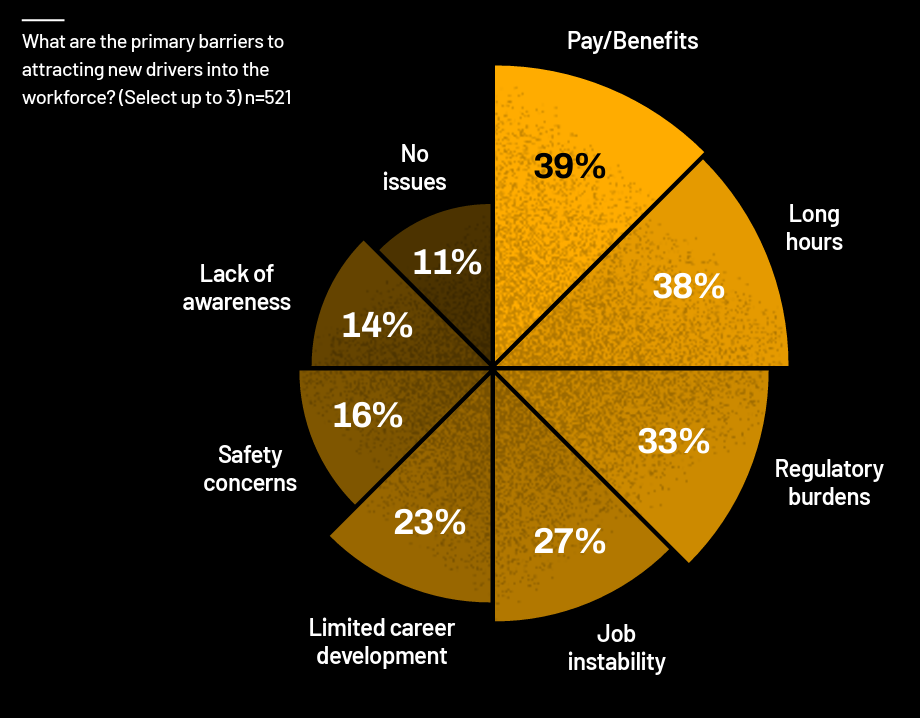The trucker shortage not only threatens the livelihood of logistics businesses, but also the health of the supply chain across the country.
Unfortunately, finding new drivers and, more importantly, retaining employed drivers has become a huge problem in the industry. 63% of logistics businesses say that their ability to recruit and retain drivers has either stagnated or worsened over the past year, according to our recently released logistics industry report.
So, what can businesses do to retain drivers? This guide will outline some of the strategies being used by logistics companies to keep their truckers happy, as well as what drivers are looking for.
What Do Truckers Not Want?
The real key to retaining your fleet is understanding what your truckers actually want. Arguably, the best way to do that is by knowing what it is they don’t like about the profession, and working backwards from there.
In our survey, we found that there are a number of barriers to the industry for potential drivers, highlighting some of the things that truckers want out of their profession in the modern era.
- Low pay/benefits (39%) – It’s not always about pay and benefits, but it is still an obviously important factor when it comes to keeping truckers happy in their positions.
- Long hours (38%) – Work-life balance is important for truckers too, and long hauls can make it hard to get on board with the profession in the long run.
- Regulatory burdens (33%) – Trucking regulations are no joke, from ELD usage to safety precautions, which can get in the way of making money for some truckers.
- Job instability (27%) – Seasonal changes to demand shifts, the reliability of trucking jobs can ebb and flow substantially, which just isn’t secure enough for some professionals.
- Limited career development (23%) – There aren’t a lot of avenues towards management positions for truckers, which means the low pay and benefits will remain without another plan.
- Safety concerns (16%) – Auto accidents are one of the leading causes of death in the US, which makes trucking a dangerous profession for those behind the wheel.
So, yes, addressing the low pay to retain your trucker shortage will help, but that’s far from the complete picture. The reality is that truckers today want more than just an increase in compensation to stay on the road; they want a multi-faceted work experience improvement, which includes work-life balance.

Strategies for Retaining Your Fleet
Understanding what your fleet wants is a good first step in retaining drivers, but knowing is only half the battle. You’ll have to use this knowledge to enact meaningful strategies that can actually move the needle in improving your workforce numbers.
Below, we’ll showcase some strategies that you can employ to retain your fleet more effectively, so you can stop worrying about your
Prioritize work-life balance
Increasing pay and benefits for drivers does help when it comes to retention, but work-life balance has quickly become one of the biggest priorities for truckers today. In fact, our survey found that the same number of businesses (56%) are focusing on improving work-life balance as increasing pay to attract new drivers.
What does this look like for the average business? Shorter hour requirements, better route optimization that accounts for rest stops, and longer vacations for long-haul truckers are a good place to start.

Offer more training and development programs
With limited career development and job instability representing two of the primary barriers for new drivers, it’s safe to say that promotion opportunities aren’t nearly available enough to make an impact. That’s why 44% of businesses are prioritizing training and development programs to improve retention.
One way to get started with this is to check out and recommend logistics certifications for your drivers, so that they can advance their careers and possibly make more in the near future.
Optimize recruitment
Retention is great when you can make it happen, but optimizing your recruitment strategy to ensure your hiring practices are sound can make a big difference for retention in the long run.
The problem is that there simply isn’t enough talent out there to fill the gaps. 45% of logistics businesses say a lack of qualified applicants is the number one biggest challenge in maintaining a steady driver workforce, which means you need to really hammer out the details before pulling the trigger on a new hire.

Improve company culture
While it may be lower on the list than other reasons, company culture is still an important aspect of employment for truckers today. How you treat employees and what your core beliefs are can seriously impact your retention numbers, and if it’s driving people away, you need to change something.
This can be hard with a trucking business, but you’ll want to make a concerted effort to foster a positive work experience outside of an office with open communication and community, so truckers feel welcomed at the company.
Utilize technology
Considering 73% of logistics businesses say that technology has already helped them address workforce challenges, it’s safe to say that using tech solutions like route optimization software, driver monitoring/coaching tools, and fuel reduction platforms is becoming the industry standard, and its usage can encourage drivers to stay put at your business.
For example, predictive maintenance can be used to overhaul your vehicle maintenance protocol. Rather than waiting for problems to develop and addressing them reactively, utilize predictive sensors to anticipate when future maintenance issues might arise. This will reduce downtime and improve the health and safety of your operators.
Recent advancements in AI can be used to improve your business. From creating contract templates and building customer service chatbots to optimizing preventative maintenance and onboarding recruits, there are plenty of ways you can utilize the innovative tech to make life easier for your drivers.

Retention Starts With Understanding the Industry
If you want to address the trucker shortage or just generally set up your business for success in the long run, you need to stay up to date on everything going on across the industry.
Luckily, Tech.co is on the case. In addition to our in-depth logistics report, we’ve got our ear to the ground, covering all the logistics news that could impact how you do business.
Make sure to download the Moving Goods with Fewer Hands report today, and check back to learn as much as you can about how you can be successful in logistics today.
